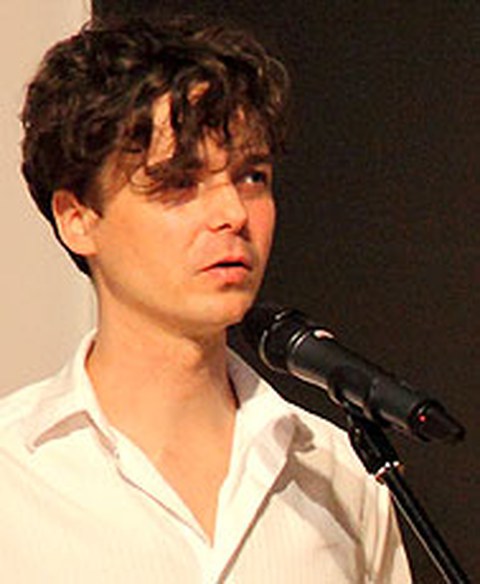The "Traumschmelze" man
(Interview from 2013)
Andreas Körner
Time is short when we arrange to meet André Eckardt. His time is always short before the start of the annual "Filmfest Dresden" international short film festival, at which the German Institute for Animated Film (DIAF) is showing a number of films and running the exhibition "Traumschmelze – Der deutsche Zeichenanimationsfilm 1930–1950." André Eckardt has been the director of DIAF since 2008, and his journey to his current role began at TU Dresden.

Poster from the current exhibition, "Traumschmelze"
Born in Berlin in 1973, Eckardt pursued an English and American Studies degree at TU Dresden from 1993 to 2001. He knew that the humanities were a fairly niche subject at TUD – but niche means freedom.
"My interest in film was huge, and I was inspired by visiting professor Theresa Grisham," says Eckardt. "She introduced me to the works of Douglas Sirk, for example. An exchange semester in Brighton, where there was a cinematheque that showed experimental animated films, finally sealed the deal for me." That semester in Brighton was in 1998/99. Smiling, Eckardt says he was "spoiled there." No wonder – there were few comparable places or opportunities in Germany at the time to indulge to such an extent in experimental contemporary and historical animation and short films. Germany might have had plenty of film museums and even festivals, but the avant-garde focus of the "Brighton Cinematheque" was unique.
Back in Dresden and back at TUD, André Eckardt set about working on his final-year dissertation. He had seen the film "Institute Benjamenta" by Timothy and Stephen Quay on the 3sat channel and quickly realized that this was exactly what he wanted to write about. His professor allowed his choice, for although the Quays are U.S. citizens, they have lived in London for a long time. "Jakob von Gunten," on which the feature film with animated scenes is based, was penned by Swiss author Robert Walser. Not the obvious choice for a dissertation in English studies. But even profs get bored with nothing but endless Shakespeare. "So I wrote my final-year dissertation on the Brothers Quay, who are absolute experts in their field," says Eckardt. An early highlight for him – and an early hint of where his career would take him – was working on the Quay retrospective at the Filmfest Dresden short film festival. The brothers attended in person and answered Eckardt's questions.

André Eckardt is the director of DIAF, the German institute for animated film.
Eckardt graduated from TUD in 2001. What came next? He initially retained his links to the university, working as a coordinator at UNIcert, the foreign language certification system for universities. "In Dresden, the German institute for animated film was close by," says Eckardt. "I started out curating series of films, followed by a part-time position as a research assistant which I took up in 2005." Increasingly, he worked on introducing people to German animated film. He gave lectures, organized themed events on the German and international stage and, in 2005, a conference of the "Society for Animation Studies" in Dresden, and worked on various publications.
In 2008, Sabine Scholze, the accomplished co-founder and head of DIAF, retired. André Eckardt took over. "For three years, I got to work together with Sabine Scholze – her with her DEFA [East German state film company studio] background, and me with my perspective on new developments. We both wanted to internationalize DIAF. After 2008, I continued those efforts and built on the more experimental angle."
The German institute for animated film, DIAF, was founded in November 1993. For a long time, the main reason for the ambitious initiative was to preserve an essential piece of German film history: Dresden, with its DEFA animation studio, was considered a major center of animated film production from 1955 to 1990. Today, DIAF seeks to operate as a network for animated film throughout Germany. Eckardt describes the institute as follows: "There are three fundamental aspects to DIAF's work: research, archiving/collection, and publicizing films through exhibitions, film series, and books and DVDs. The term 'institute' is clearly a bit confusing – we occasionally receive inquiries from people wanting to study animated film at DIAF. That, by the way, would be our big dream for a fourth area of work; but as it stands now, DIAF is an association operating with three to five part-time employees." Today, DIAF is respected for its combination of old and new. The DEFA collection inherited by DIAF (artistic material and more than 2000 films) has not meant the "construction of a mausoleum." Instead, it is increasingly forming the basis for engagement with the contemporary. "Incidentally, we had a slightly bizarre experience with 'Sandmännchen' [the 'Sandman' children's TV program]. Many people think that the GDR children's bedtime television program was made in Dresden. That is not true, and so we don't have the archive material here either. Six years ago, however, we managed to acquire a large collection from the father of the West German 'Sandmännchen' program. It's a good thing that we are not purely focused on the East and are no longer restricted to that geographical area either. There has long been interregional cooperation, for example with Germany's leading animation film festival in Stuttgart. Nationwide and internationally, we have a great standing as a research center. Our unique selling point is precisely that there are no comparable bodies that work specifically and so in-depth with animated film and its history. We fill a niche and can rightfully claim to have one of the largest collections of animated films in Germany."

Animation drawings and background by Werner Bernhardy for the "Afro auf Reisen" (1941) advertising film for candies from the Saxon Afro-Werke factory
The current DIAF exhibition, "Traumschmelze – Der deutsche Zeichenanimationsfilm 1930–1950," runs at the Technical Collections Dresden (TSD) until September 1, 2013. A great collection from a difficult and volatile era. DIAF director and expert in his field André Eckardt is conscious of the unique nature of the exhibition. "It ranges from avant-garde to applied art; from advertising film to fierce propaganda. This complex mix had us hard at work for a long time. And the result of that work is a multi-faceted picture with many shades of gray. We were very surprised to find that there was more continuity than disruption in that period. For the first time, we have included Dresden's Boehner film production company, which was very active in the advertising sector in the 1930s and 1940s and set up the building into which the DEFA animated film studio later moved. So, we have come full circle."
From his interest in film encouraged by a TU visiting professor to his everyday work in the profession, things have also come full circle for André Eckardt himself. For now.
Contact details:
Deutsches Institut für Animationsfilm (DIAF)
André Eckardt
Email: André Eckardt
Web: DIAF
